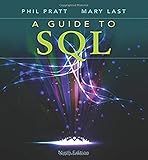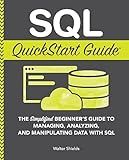Best SQL Tools to Buy in October 2025

SQL Hacks: Tips & Tools for Digging Into Your Data
- AFFORDABLE PRICES FOR QUALITY READS AT A FRACTION OF NEW COSTS.
- ECO-FRIENDLY CHOICE: GIVE BOOKS A SECOND LIFE AND REDUCE WASTE.
- UNIQUE FINDS: DISCOVER RARE TITLES AND HIDDEN GEMS FROM THE PAST.



SQL Programming QuickStudy Laminated Reference Guide



Practical SQL, 2nd Edition: A Beginner's Guide to Storytelling with Data



SQL Pocket Guide: A Guide to SQL Usage



RPG & SQL: Style and productivity: Guide to coding style, practices and productivity tools for the IBM i platform



SQL Practice Problems: 57 beginning, intermediate, and advanced challenges for you to solve using a “learn-by-doing” approach



Head First SQL: Your Brain on SQL -- A Learner's Guide



A Guide to SQL



SQL QuickStart Guide: The Simplified Beginner's Guide to Managing, Analyzing, and Manipulating Data With SQL (Coding & Programming - QuickStart Guides)


To get the highest count from list data in MySQL, you can follow the steps below:
- Use the COUNT() function: The COUNT() function in MySQL is used to count the number of rows returned by a query. It can also be used to count the occurrences of specific values in a column.
- Specify the table and column: Identify the table and column from which you want to count the occurrences of data.
- Group the data: If you have multiple rows in your table, you may need to group the data based on a specific column using the GROUP BY clause. This is necessary to perform aggregate functions, like COUNT(), on specific groups of data.
- Sort the result: To get the highest count, you need to sort the result in descending order. You can use the ORDER BY clause and specify the column you used in the COUNT() function, followed by the keyword "DESC" to sort the data in descending order.
- Retrieve the first row: By limiting the result to one row using the LIMIT 1 clause, you can retrieve the row with the highest count.
Here is an example query that demonstrates these steps:
SELECT column_name, COUNT(column_name) AS count FROM table_name GROUP BY column_name ORDER BY count DESC LIMIT 1;
Replace column_name with the actual column name in your table and table_name with the actual table name. The result will provide you with the value from the specified column that has the highest count in descending order.
How to perform a subquery in MySQL?
To perform a subquery in MySQL, follow these steps:
- Start by writing the outer query. This is the main query that will return the final result.
- Within the outer query, specify the column(s) you want to display in the final result.
- Use the SELECT statement to write the inner query. This is the subquery that will be executed first, and its result will be used in the outer query.
- Specify the table(s) you want to retrieve data from in the inner query, using the FROM clause.
- Define any necessary conditions or filters within the inner query, using the WHERE clause.
- Use the result of the inner query in the outer query by referencing it in the appropriate place. This is usually done in the WHERE, JOIN, or FROM clauses of the outer query.
- Optionally, you can add additional clauses, such as ORDER BY or GROUP BY, to further refine your query.
Here's an example to help you understand the process:
SELECT column1, column2, ... FROM table1 WHERE column1 IN (SELECT column1 FROM table2 WHERE condition);
In this example, the subquery (SELECT column1 FROM table2 WHERE condition) is executed first, and its result (a list of values from column1 in table2 that satisfy the given condition) is then used in the outer query to filter the rows retrieved from table1.
Remember to adjust the table and column names, as well as the conditions, according to your specific database schema and requirements.
How to update data in MySQL table?
To update data in a MySQL table, you can use the following steps:
- Connect to the MySQL database using a database connection tool or the command-line interface.
- Select the specific database where your table exists using the command: USE database_name;
- Use the UPDATE statement to modify the data in the table. The basic syntax is: UPDATE table_name SET column1=value1, column2=value2 WHERE condition; table_name is the name of the table you want to update. column1, column2, etc. are the specific columns you want to update. value1, value2, etc. are the new values you want to assign to the columns. condition specifies the rows to be updated. If no condition is specified, all rows will be updated. For example, if you have a table called "users" and you want to update the "email" column for a specific user with an ID of 1, the query would be: UPDATE users SET email='newemail@example.com' WHERE id=1;
- Execute the SQL statement to update the data.
- Verify the data has been updated by querying the table again: SELECT * FROM table_name; This will retrieve all the rows from the table, allowing you to confirm that the specified changes have been made.
Remember to be cautious when modifying data in a table, especially without providing appropriate conditions.
How to join two tables in MySQL?
To join two tables in MySQL, you can use the JOIN keyword in your SQL query. Here are the steps to join two tables:
- Specify the tables you want to join in the FROM clause of your SQL query. For example, if you have two tables named "table1" and "table2", the statement will be: SELECT * FROM table1, table2
- Specify the join conditions using the ON keyword in the WHERE clause of your query. The join condition is usually the common column between the two tables. For example, if the common column is "id", the statement will be: SELECT * FROM table1, table2 WHERE table1.id = table2.id
- Specify the columns you want to retrieve from the two tables. Instead of using "*" to retrieve all columns, you can specifically mention the columns using the table names or aliases if you have used any. For example, to retrieve columns "column1" and "column2" from "table1" and "column3" from "table2", the statement will be: SELECT table1.column1, table1.column2, table2.column3 FROM table1, table2 WHERE table1.id = table2.id
- Use different types of joins based on your requirement: INNER JOIN: Returns only the rows that have matching values in both tables LEFT JOIN: Returns all records from the left table and matching records from the right table RIGHT JOIN: Returns all records from the right table and matching records from the left table FULL JOIN: Returns all records when there is a match in either left or right table You can specify the type of join by using the appropriate keyword before the JOIN keyword. For example, to perform an INNER JOIN, the statement will be: SELECT * FROM table1 INNER JOIN table2 ON table1.id = table2.id By default, if you don't specify a join type, MySQL uses INNER JOIN.
Note: It is recommended to use explicit JOIN syntax (using INNER JOIN, LEFT JOIN, etc.) rather than using comma-separated table names in the FROM clause, as it makes the query more readable and avoids confusion.
What is a temporary table in MySQL?
A temporary table in MySQL is a table that is created and used for a specific session or query. It exists only for the duration of that session or query and is automatically dropped and deleted once the session or query ends. Temporary tables are useful in situations where you need to store and manipulate data temporarily, without persisting it in the database permanently. They can be used to hold intermediate results of complex queries, store temporary data during data manipulation operations, or simplify complex queries by breaking them into smaller, manageable parts.
What is the WHERE clause in MySQL?
The WHERE clause in MySQL is utilized to filter the rows returned by a SELECT statement. It specifies a condition that must be met for a row to be included in the result set. The WHERE clause is typically added after the FROM clause in a SELECT statement and can be used with various operators such as "=", "<", ">", "<=", ">=", "<>", "LIKE", "IN", and more to compare column values against given values or expressions. This helps in narrowing down the results based on specific criteria.
